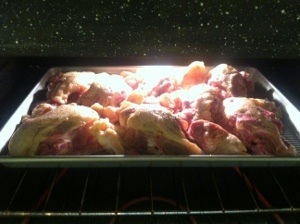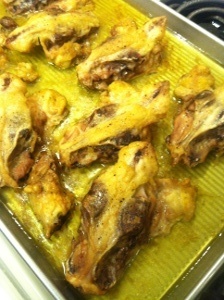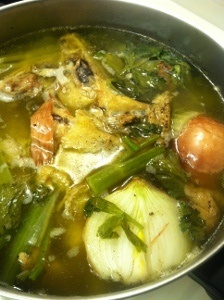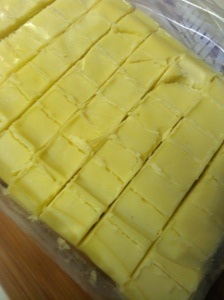Cook Chicken Once And Eat Three Ways – Meat, Stock, and Schmaltz
There are a lot of ways to get the most out of a chicken. I like to roast a whole chicken for dinner, then make homemade chicken broth out of the carcass, skin, bones, and drippings. All the lovely flavors are there for the stock, and you have a whole chicken to feed the family. In this way, nothing is wasted.
My friend Patti Winker of RemarkableWrinklies.com has another method she likes which produces not only a small chicken meal and the makings for stock, but also solid chicken fat, known as schmaltz. If you like the flavor chicken fat (schmaltz) provides in frying, this method may be perfect for you. One other benefit to this sort of method is how cheap it is. Take a look at the instructions and pictures Patti has provided us and see if this method appeals to you. And, be sure to leave your comments below to share your ideas.
Hi Susanne. Thank you for letting me share my ‘recipe’ here.
This little cooking  experiment started when I ran to the store to get chicken thighs for dinner. I usually buy chicken thighs because I prefer the flavor and because they are cheaper than chicken breasts. Right next to the thighs in the meat department I saw packages of ‘necks and backs’ at such a low price it was like they were giving them away. I know the backs of a chicken are quite fatty so I knew they would make a nice stock. So, I bought the thighs for dinner and a package of the ‘necks and backs’ for the stock.
experiment started when I ran to the store to get chicken thighs for dinner. I usually buy chicken thighs because I prefer the flavor and because they are cheaper than chicken breasts. Right next to the thighs in the meat department I saw packages of ‘necks and backs’ at such a low price it was like they were giving them away. I know the backs of a chicken are quite fatty so I knew they would make a nice stock. So, I bought the thighs for dinner and a package of the ‘necks and backs’ for the stock.
Before I put the thighs and backs on the baking sheet, I seasoned everything, including the backs, with salt, pepper and sage. Then I roasted them at 350 degrees for about 45 minutes, until the thighs were totally cooked through and the skin was crispy.
What I noticed  was the incredible amount of chicken fat that cooked off. I knew the backs would be fatty and full of flavor for the broth, but it only occurred to me when I saw the inch of fat in the baking sheet that I would have enough fat to save for schmaltz. (You might want to put the chicken thighs on a rack inside the baking sheet to keep them up out of the fat since you’re going to eat those.)
was the incredible amount of chicken fat that cooked off. I knew the backs would be fatty and full of flavor for the broth, but it only occurred to me when I saw the inch of fat in the baking sheet that I would have enough fat to save for schmaltz. (You might want to put the chicken thighs on a rack inside the baking sheet to keep them up out of the fat since you’re going to eat those.)
When the chicken was cooked, I removed the thighs to a paper towel covered rack to drain and set aside for dinner.
Now it’s time to get the stock started.
I dumped the backs and all the fat from the baking sheet into a large pot, added onion, celery, and peppercorns to the pot, then filled it with water and brought it to a boil. As soon as the pot came to a boil, I turned the heat down and slowly simmered it for a couple hours, stirring often.
Of course, the stock was very fatty because I dumped all the fat from the baking pan into the pot. This provides a lot of flavor to the stock, but the fat is going to be skimmed off from the stock and saved for the schmaltz. You can keep as much or as little fat in the stock as you want simply by skimming off more or less fat.
 After the stock has simmered at least an hour or two, remove it from the stove, let it cool slightly, and pour through a strainer into a bowl or another large pot. (Discard all the strained out bones, etc.) Put the strained stock into the freezer and allow to cool (uncovered) overnight. The next day you will have a solid layer of fat on the top of the stock in the freezer.
After the stock has simmered at least an hour or two, remove it from the stove, let it cool slightly, and pour through a strainer into a bowl or another large pot. (Discard all the strained out bones, etc.) Put the strained stock into the freezer and allow to cool (uncovered) overnight. The next day you will have a solid layer of fat on the top of the stock in the freezer.
Now you can prepare your schmaltz.
Remove the pot of chicken stock from the freezer. Carefully scrape/peel the solid fat off the top of the stock and put it in a saucepan over medium heat. Bring to a gentle boil, stirring, and when the fat is liquid again, pour it through a fine mesh strainer or sieve into a clean bowl. Line a baking pan with parchment paper and pour the strained chicken fat into the baking pan. Put the baking pan into the freezer and allow to freeze solid, usually overnight.
Now back to the stock.
You can bring the stock that remains in the pot back up to a boil so you can strain it once more if you wish. Once your stock is as you like it, pour into freezer or refrigerator containers and store accordingly.
Time to cut up the schmaltz.
The next day, remove the baking pan from the freezer, lift the schmaltz out using the parchment paper. Lay it on a cutting board and cut into squares with a sharp knife to make it easy to use. Work quickly because the schmaltz melts fast. Put the squares in freezer containers and keep frozen. Use these schmaltz squares just like you would butter or oil to fry eggs or other foods. I’ve used it for stir-fry meals or even just to add a bit of flavor to rice, noodles, potatoes, or soups. Some folks use schmaltz as a spread on bread or bagels.
Some folks use schmaltz as a spread on bread or bagels.
The frugal results.
In this one cooking experiment I ended up with a chicken dinner for two with leftovers, 4 quarts of stock, and a large freezer bag filled with schmaltz. This figures out to about six meals and a seemingly endless supply of chicken fat for frying and flavoring. Not a bad return on an investment of a few dollars! I hope you’ll give it a try and let us know how it worked for you and share any suggestions you have.
p.s. My husband and I are NOT on fat restrictive diets and we enjoy eating and cooking with animal fats and proteins. This type of cooking and eating is not for everyone, but if you eat like we do, close to what is known as a ‘Paleo’ diet, you might like to try this.
Note from Susanne: In the comments section, there have been a few questions about keeping the chicken stock from getting cloudy. It seems we can agree that making sure the stock simmers slowly helps keep the stock clearer and cleaner by preventing the carcass from breaking up during a harder boil. Patti Winker posted a video on YouTube to illustrate a ‘slow rolling boil’ which she suggests is the proper ‘speed’ for producing a good stock. I thought I’d share the video here so you could take a look. Be sure to leave your comments after you view the video. And while we’re talking about old fashioned cooking, be sure to check out Patti’s fun ecookbook at MemoryLaneMeals.com. Thank you.
For more recipes for simple mixes and “convenience foods” that you can make yourself, check out:
Homemade Mixes – Make It Yourself and Save
 Making your own mix from scratch rather than buying it in the store not only saves you money but also saves you from all the additives and preservatives that are put in the foods we buy. The recipes include:
Making your own mix from scratch rather than buying it in the store not only saves you money but also saves you from all the additives and preservatives that are put in the foods we buy. The recipes include:
- Apple Pie Spice Mix
- Basic Muffin Mix
- Brownie Mix
- Caribbean Jerk Seasoning
- Chocolate Chip Cookie Mix
- Corn Bread Mix
- Cream of Soup Mix
- Fajita Seasoning
- Fish Fry Coating Mix
- Fruited Oatmeal Mix
- Homemade Taco Seasoning Mix
- Homemade Vanilla Chai Tea Mix
To support the blog, check out the HBHW eBooks available on Amazon. Thank you!
Disclosure: Some of the links below are affilate links, meaning, at no additional cost to you, I will earn a commission if you click through and make a purchase.

